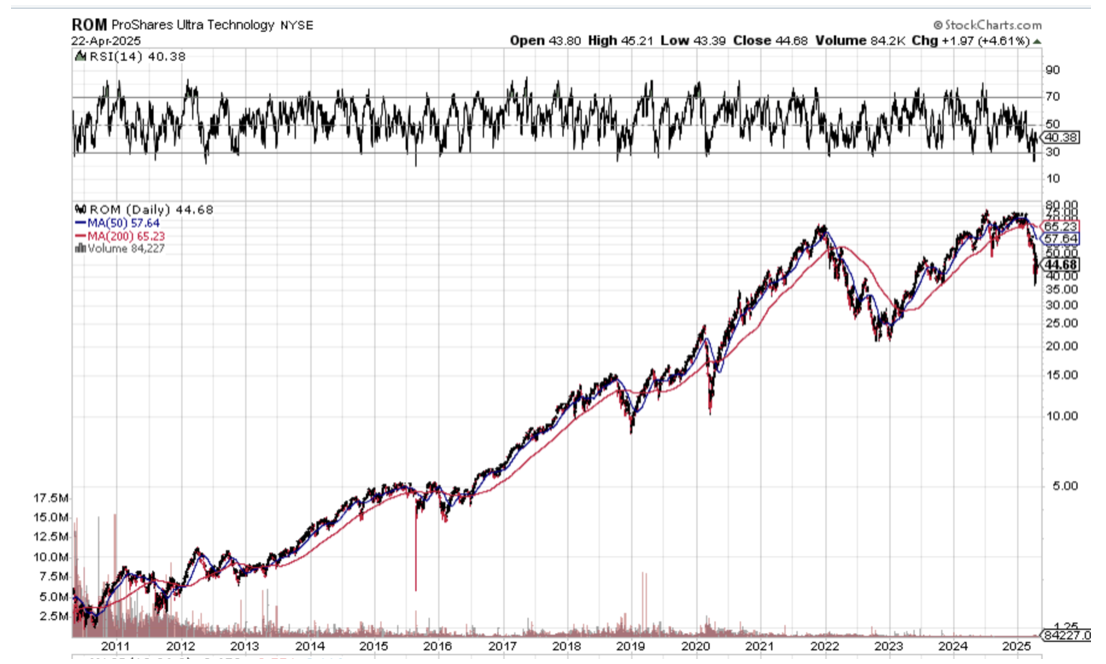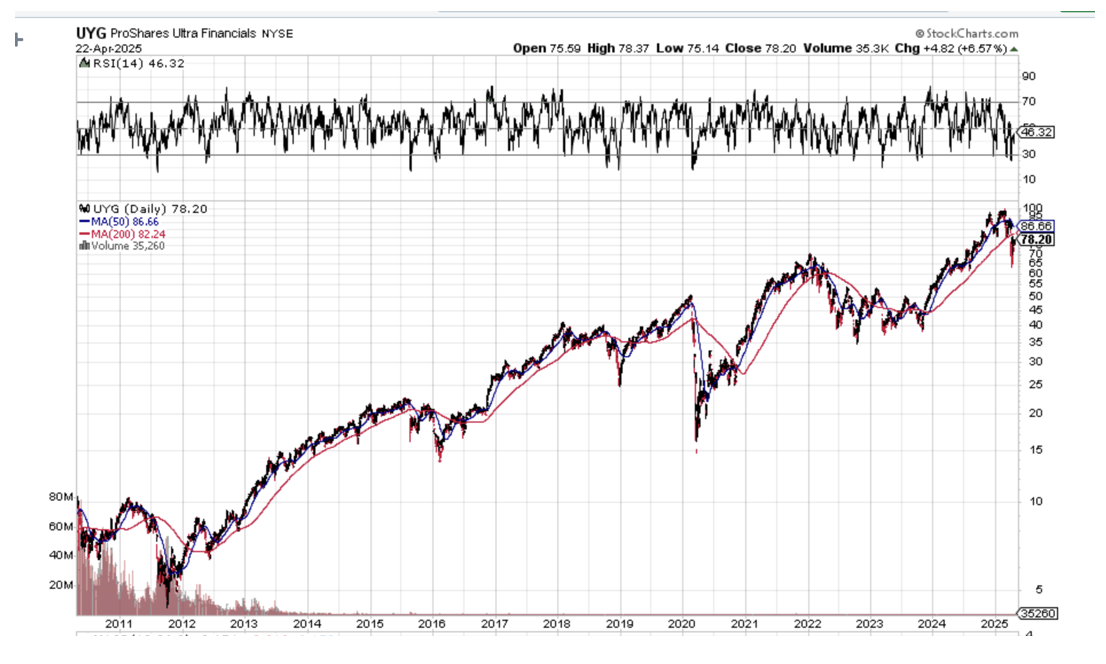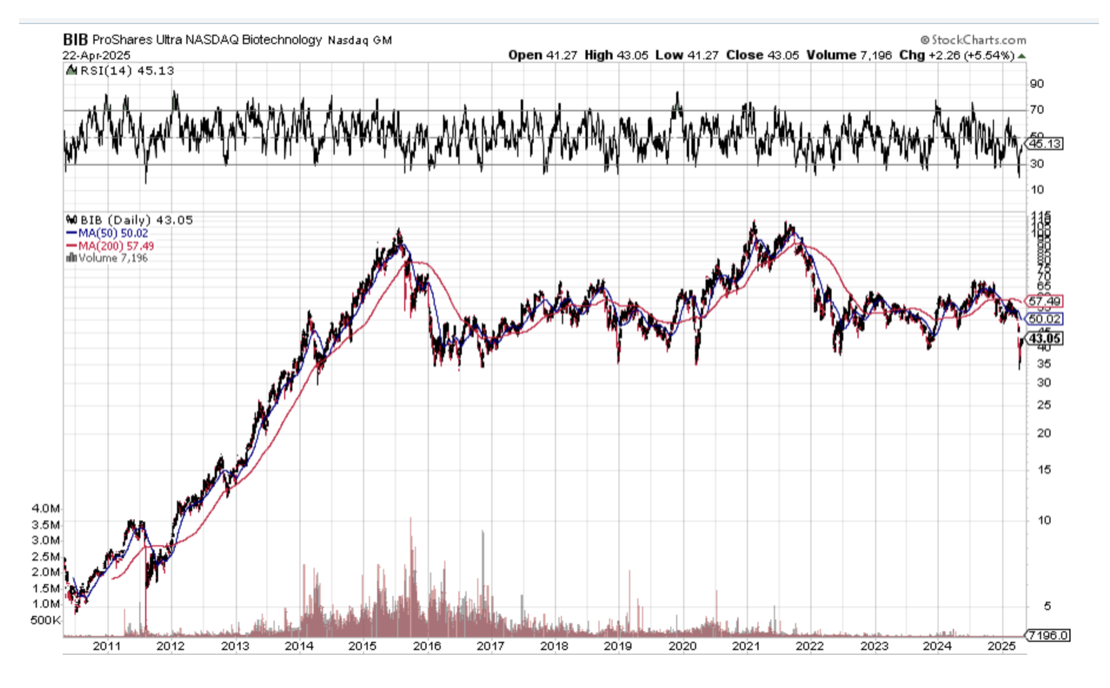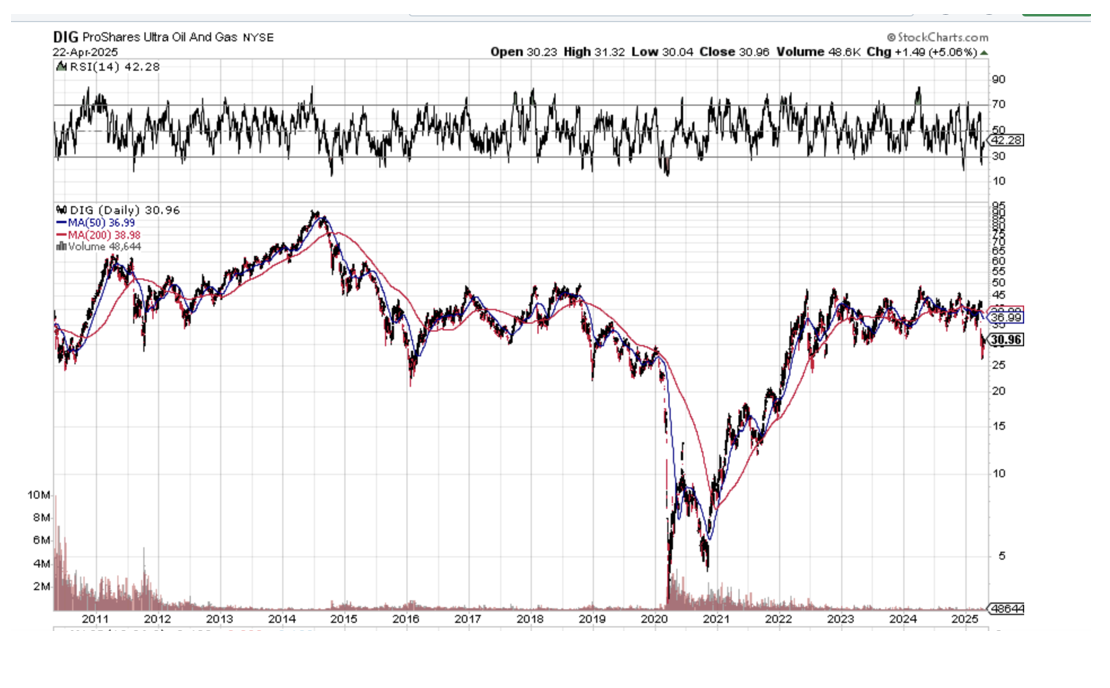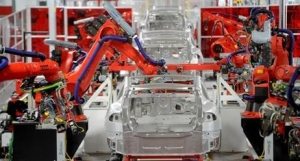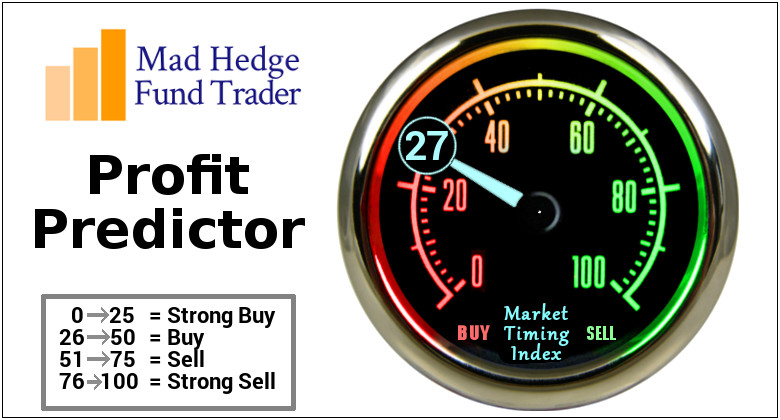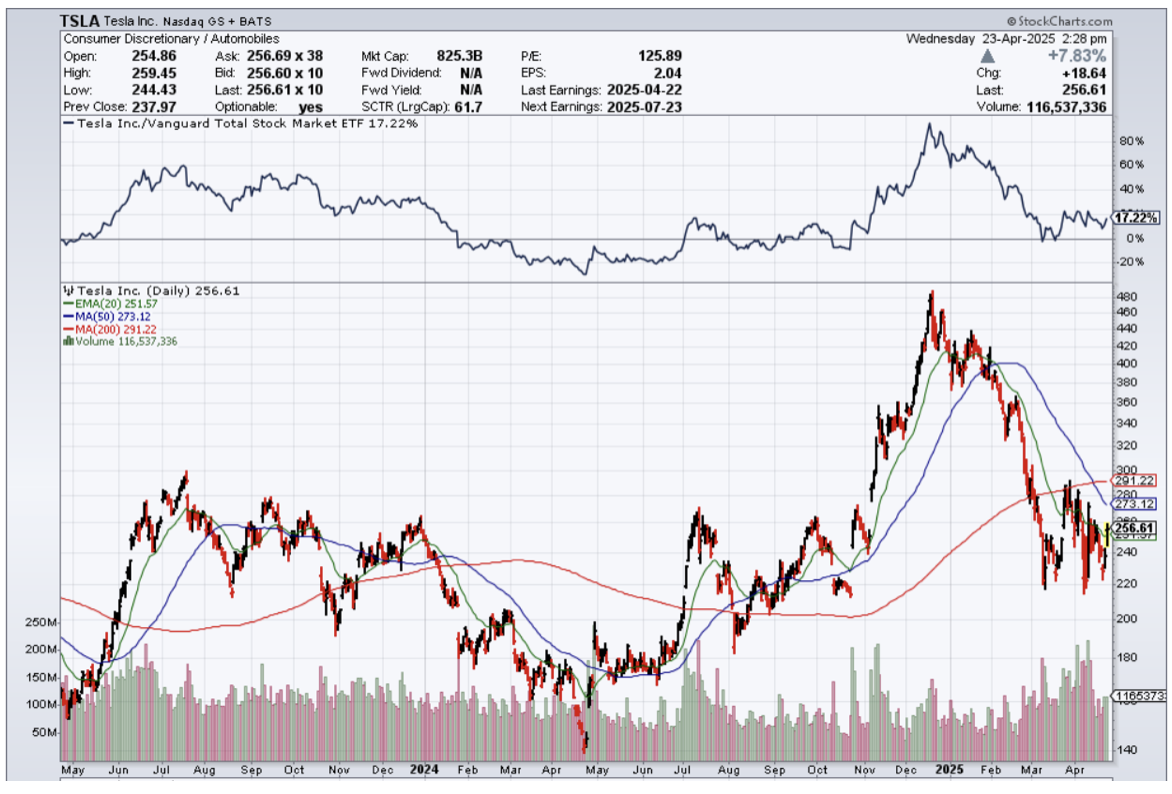When John identifies a strategic exit point, he will send you an alert with specific trade information as to what security to sell, when to sell it, and at what price. Most often, it will be to TAKE PROFITS, but, on rare occasions, it will be to exercise a STOP LOSS at a predetermined price to adhere to strict risk management discipline. Read more
Global Market Comments
April 24, 2025
Fiat Lux
Featured Trade:
(TESTIMONIAL),
(MY FAVORITE PASSIVE/AGGRESSIVE PORTFOLIO)
(ROM), (UYG), (UCC), (DIG), (BIB)
Gosh darn it, you nailed it again!
Trump stopped firing Powell. Banks are on fire. Netflix hit a new high.
Score John Thomas 100, everyone else zero.
Well done, John AND let's keep it going.
You're the Savant of the time at the moment.
Talk to you soon, bye.
Bill
Florida
What if you want to be a little more aggressive with your investment strategy, say twice as aggressive? What if markets don’t deliver any year-on-year change from here?
Then you need a little more pizzazz in your portfolio, and some extra leverage to earn your crust of bread and secure your retirement.
It turns out that I have just the solution for you. This would be my “Passive/Aggressive Portfolio”.
I call it passive in that you just purchase these positions and leave them alone, and do not trade them. I call it aggressive as it involves a basket of 2x leveraged ETFs issued by ProShares, based in Bethesda, MD (click here for their link).
The volatility of this portfolio will be higher. But the returns will be double what you would get with an index fund, and possibly much more. It is a “Do not open until 2035” kind of investment strategy.
Here is the makeup of the portfolio:
(ROM) –- ProShares Ultra Technology Fund - The three largest single stock holdings are Apple (AAPL), Microsoft (MSFT), and Facebook (FB). It is up 13.7% so far this year. For more details on the fund, please click here.
(UYG) – ProShares Ultra Financials Fund - The three largest single stock holdings are Wells Fargo (WFC), Berkshire Hathaway (BRK.B), and JP Morgan Chase (JPM). It is up 6.2% so far this year. For more details on the fund, please click here.
(UCC) – ProShares Ultra Consumer Services Fund - The three largest single stock holdings are Amazon (AMZN), (Walt Disney), (DIS), and Home Depot (HD). It is up 18.3% so far this year. For more details on the fund, please click here.
(DIG) -- ProShares Ultra Oil & Gas Fund - The three largest single stock holdings are ExxonMobile (XOM), Chevron (CVX), and Schlumberger (SLB). It is DOWN 38.2% so far this year. For more details on the fund, please click here.
(BIB) – ProShares Ultra NASDAQ Biotechnology Fund – The three largest single stock holdings are Amgen (AMGN), Regeneron (REGN), and Gilead Sciences (GILD). It is up 15% so far this year, but at one point (before the “Sell in May and Go away” I widely advertised) it was up a positively stratospheric 64%. For more details on the fund, please click here.
You can play around with the sector mix at your own discretion. Just focus on the fastest-growing sectors of the US economy, which the Mad Hedge Fund Trader does on a daily basis.
It is tempting to add more leveraged ETFs for sectors like gold (UGL) to act as an additional hedge.
There is also the 2X short Treasury bond fund (TBT), which I have been trading in and out of for years, a bet that long-term bonds will go down, and interest rates rise.
There are a couple of provisos to mention here.
This is absolutely NOT a portfolio you want to own going into a recession. So, you will need to exercise some kind of market timing, however occasional.
The good news is that I make more money in bear markets than I do in bull markets because the volatility is so high. However, to benefit from this skill set, you have to keep reading the Diary of a Mad Hedge Fund Trader.
There is also a problem with leveraged ETFs in that management and other fees can be high, dealing spreads wide, and tracking errors can be huge.
This is why I am limiting the portfolio to 2X ETFs and avoiding their much more costly and inefficient 3X cousins, which are really only good for intraday trading. The 3X ETFs are really just a broker enrichment vehicle.
There are also going to be certain days when you might want to just go out and watch a long movie, like Gone with the Wind, with an all-ETF portfolio, rather than monitor their performance, no matter how temporary it may be.
A good example was the May 6, 2010, flash crash, when the complete absence of liquidity drove all of these funds to huge discounts to their asset values.
Check out the long-term charts, and you can see the damage that was wrought by high-frequency traders on that cataclysmic day, down -53% in the case of the (ROM). Notice that all of these discounts disappeared within hours. It was really just a function of the pricing mechanism being broken.
I have found the portfolio above quite useful when close friends and family members ask me for stock tips for their retirement funds.
It was perfect for my daughter, who won’t be tapping her teacher’s pension accounts for another 30 years, when I will be long gone. She mentions her blockbuster returns every time I see her, and she has only been in them for 10 years.
Imagine what technology, financial services, consumer discretionaries, biotechnology, and oil and gas will be worth then? It boggles the mind. My guess is up 100-fold from today’s levels.
You won’t want to put all of your money into a single portfolio like this. But it might be worth carving out 10% of your capital and just leaving it there.
That will certainly be a recommendation for financial advisors besieged with clients complaining about paying high fees.
Adding some spice and a little leverage to their portfolios might be just the ticket for them.
The Istanbul Spice Market
It’s Time to Spice Up Your Portfolio
"The question is not whether Tesla will sell 80,000 or 90,000 cars this year, but whether they will sell 14 million or 15 million in 15 years. I believe they can do it," said Ron Baron of long-term value player, Baron Capital.
When John identifies a strategic exit point, he will send you an alert with specific trade information as to what security to sell, when to sell it, and at what price. Most often, it will be to TAKE PROFITS, but on rare occasions, it will be to exercise a STOP LOSS at a predetermined price to adhere to strict risk management discipline. Read more
The relationship between global trade policies and the technology sector is becoming increasingly intertwined. With tariffs on essential materials like steel and aluminum recently being implemented or proposed, the ripple effects extend far beyond construction and manufacturing. One area significantly impacted is the data center industry, which forms the backbone of the AI revolution. This article explores how rising costs for data center construction and maintenance, driven by tariffs, could indirectly influence AI processing and infrastructure development.
The Role of Steel and Aluminum in Data Centers
Data centers, the physical facilities housing servers and computing equipment, depend heavily on materials like steel and aluminum for their construction and operation. Steel is essential for building the structural framework, server racks, and enclosures, while aluminum is used for components like cooling systems, wiring, and casings. These materials ensure the physical stability and functionality of the centers, enabling uninterrupted service.
As AI technologies continue to advance, the demand for high-performance computing (HPC) systems, extensive storage solutions, and energy-efficient cooling mechanisms grows. This reliance on steel and aluminum makes data centers particularly vulnerable to price fluctuations in these materials.
Tariffs and Rising Material Costs
Tariffs, which are taxes imposed on imported goods, can significantly increase the cost of steel and aluminum. For example:
- If the U.S. imposes a 25% tariff on steel and a 10% tariff on aluminum, these additional costs are typically passed down to consumers and businesses, including data center operators.
- Countries responding with retaliatory tariffs can further disrupt the global supply chain, limiting the availability of these materials.
The result is a surge in prices for raw materials needed to construct and upgrade data centers, thereby increasing the capital expenditure for companies in the tech industry.
Escalating Construction Costs
Building a data center is already a capital-intensive process, often costing hundreds of millions of dollars. Tariffs on steel and aluminum can inflate these costs in several ways:
- Structural Framework: Steel used for constructing the data center's skeleton becomes more expensive, pushing up the overall budget.
- Server Racks: Custom steel racks designed to hold servers may see price hikes, particularly for high-density data centers.
- Cooling Systems: Aluminum-based cooling systems, essential for maintaining optimal operating temperatures, also become costlier.
These increased expenses can lead to delays in new data center projects, as companies may require additional time to secure funding or reevaluate the feasibility of their investments.
Operational Impacts and Maintenance Costs
The impact of tariffs is not limited to initial construction. Data centers require regular maintenance and upgrades, often involving steel and aluminum components:
- Replacement of Structural Elements: Periodic reinforcement or repairs to steel frameworks are standard practices.
- Cooling System Upgrades: AI workloads generate significant heat, necessitating frequent enhancements to aluminum cooling systems.
- Expansion Projects: Growing demand for AI processing often requires scaling data centers, which becomes more expensive under tariff-induced price hikes.
These operational challenges can hinder a company's ability to maintain its infrastructure, reducing its capacity to support AI workloads.
Indirect Effects on AI Processing
AI systems, from natural language processing to autonomous vehicles, rely on the computational power provided by data centers. When tariffs drive up data center costs, the following indirect effects on AI processing can be observed:
- Higher Service Costs: Cloud service providers like AWS, Microsoft Azure, and Google Cloud may pass on the increased costs to customers, raising the price of AI-related services.
- Slower AI Development: Companies may reduce their investment in AI research and development to offset higher infrastructure expenses.
- Geographical Shifts: Firms might relocate data centers to countries with lower material costs or fewer tariffs, potentially disrupting AI processing continuity and access.
Innovation and Energy Efficiency Challenges
Data centers are continually evolving to become more energy-efficient and environmentally friendly. However, tariffs can create roadblocks in this journey:
- Delay in Upgrades: Higher costs for materials may postpone the adoption of advanced cooling systems and energy-saving technologies.
- Limited Resources for Innovation: Companies may prioritize cost-cutting over research into sustainable data center solutions, hindering progress in green computing.
These challenges are particularly concerning given the growing energy demands of AI technologies, which already contribute to the carbon footprint of the tech industry.
Global Trade and Supply Chain Dynamics
Tariffs also affect the global supply chain for steel and aluminum, introducing additional complexities for data center operators:
- Supply Shortages: Retaliatory tariffs between countries can reduce the availability of materials, leading to project delays and cost overruns.
- Increased Import Costs: Companies relying on imported steel and aluminum may face logistical challenges and higher transportation expenses.
These dynamics further underscore the interconnectedness of global trade policies and the AI ecosystem.
Mitigation Strategies
Despite these challenges, companies can adopt strategies to mitigate the impact of tariffs on data centers and AI infrastructure:
- Diversifying Supply Chains: Sourcing materials from multiple countries can reduce reliance on tariff-affected imports.
- Investing in Recycling: Using recycled steel and aluminum can lower costs and promote sustainability.
- Leveraging Government Incentives: Applying for tax credits or subsidies for green initiatives can offset some expenses.
These proactive measures can help companies navigate the complexities of tariffs while continuing to invest in AI development.
Conclusion
The imposition of tariffs on materials like steel and aluminum presents significant challenges for the data center industry, indirectly affecting AI processing and infrastructure. By driving up construction and maintenance costs, tariffs could slow the growth of AI technologies, limit innovation, and disrupt global supply chains.
However, with strategic planning and collaboration, companies can mitigate these impacts and ensure the continued advancement of AI. As the relationship between trade policies and technology evolves, the industry must remain adaptable and forward-thinking to overcome these obstacles.
When John identifies a strategic exit point, he will send you an alert with specific trade information on what security to sell, when to sell it, and at what price. Most often, it will be to TAKE PROFITS, but, on rare occasions, it will be to exercise a STOP LOSS at a predetermined price to adhere to strict risk management discipline. Read more
Mad Hedge Technology Letter
April 23, 2025
Fiat Lux
Featured Trade:
(TESLA HITS AN AIR POCKET)
(TSLA)
Tesla (TSLA) has problems and so do other tech firms at the start of 2025.
Saying that doesn’t give comfort even with a great bull market of 12 years.
The scary thing here is that many tech bulls might believe this is the end of the stock market party.
Moving forward, we will see many tech firms miss gross revenue and profitability.
Then there is the future forecast and I wouldn’t blame management on making excuses using the trade war which they can’t control.
Tesla missed their first quarter revenue target by nearly $2 billion.
Management has literally been in Washington DC getting into politics, and that has hurt Tesla’s stock.
Tesla’s stock almost halved to around $200 before catching a bid.
CEO and Founder Elon Musk said he will step back from his role with DOGE, staying involved part time.
He said he'll continue to spend a day or two a week on government matters, for as long as President Donald Trump wants him to.
Looking forward, a potential key revenue driver is the robo-taxi.
Tesla is set to debut this service in Austin this June, starting with "maybe 10 to 20 vehicles," Musk said.
Tesla also confirmed on the call that the initial launch will include remote human operators who can intervene if a vehicle becomes stuck or encounters an issue.
Musk said the goal is to bring the service to "many other cities in the US by the end of this year," predicting that "there will be millions of Teslas operating fully autonomously in the second half of next year."
Musk said that Tesla would be "the least affected car company" when it comes to tariffs.
"With respect to supply chain risk, something that Tesla has been working on for several years, is to localize supply chains," Musk said. "Tariffs are still tough on a company when margins are still low, but we do have localized supply chains in both America, Europe, and China, so that puts us in a stronger position than any of our competitors."
I do believe the low 200 level for the stock should hold as resistance for TSLA.
Much of the bad news, and there is a lot, is already priced into the stock.
It will be interesting to see if the brand recovers, because the product is deeply unpopular in California and Western Europe.
To be honest, while we wait on the robo-taxi to roll out, Musk saw an air pocket and we are hitting that with full turbulence.
That being said, if there was not a change of administration, there is no way he could make headway with the robo-taxi division.
Musk is waiting on the robo-taxi to save the day and the possibility that happens is better than 50%. In the meantime, I believe he will have a hard time moving sales of his standard EV. He has done a lot of damage by alienating half of his addressable audience.
I believe the stock slowly creeps higher, but in a volatile way.
As for Musk, I think he’ll be spending more time at his day job moving forward and that should help the stock just for that.
Legal Disclaimer
There is a very high degree of risk involved in trading. Past results are not indicative of future returns. MadHedgeFundTrader.com and all individuals affiliated with this site assume no responsibilities for your trading and investment results. The indicators, strategies, columns, articles and all other features are for educational purposes only and should not be construed as investment advice. Information for futures trading observations are obtained from sources believed to be reliable, but we do not warrant its completeness or accuracy, or warrant any results from the use of the information. Your use of the trading observations is entirely at your own risk and it is your sole responsibility to evaluate the accuracy, completeness and usefulness of the information. You must assess the risk of any trade with your broker and make your own independent decisions regarding any securities mentioned herein. Affiliates of MadHedgeFundTrader.com may have a position or effect transactions in the securities described herein (or options thereon) and/or otherwise employ trading strategies that may be consistent or inconsistent with the provided strategies.





